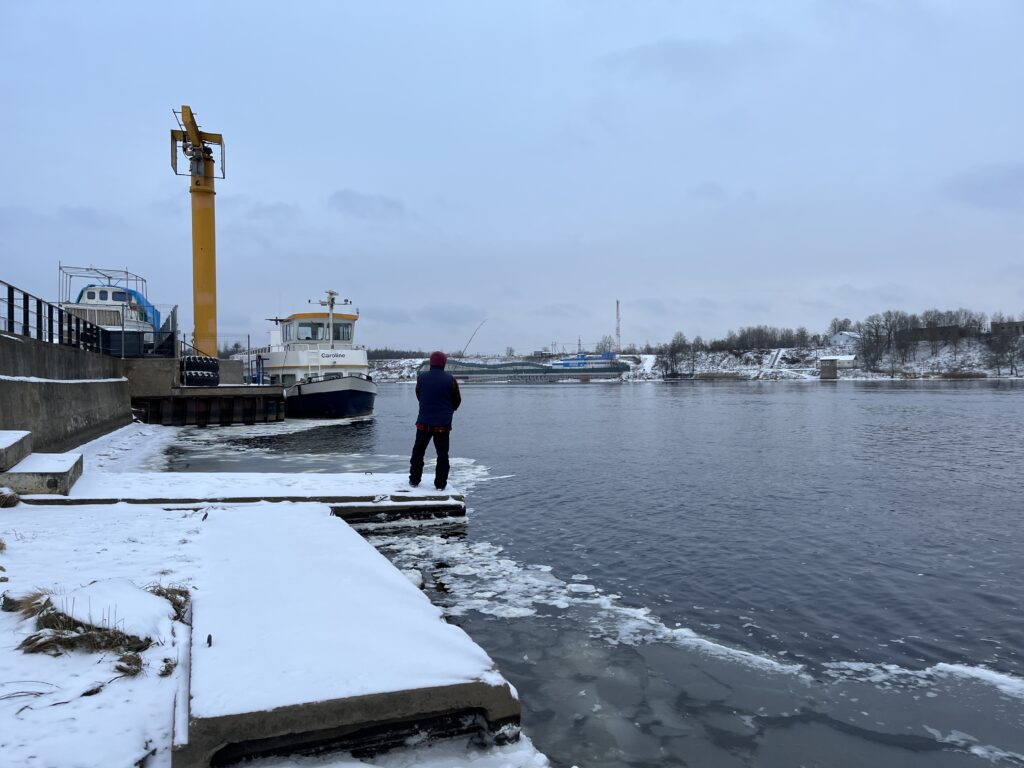Through its use of language, Estonia is trying to connect the eastern and western parts of the country. Over a quarter of the Estonian population is ethnic Russian; a large part of them considers Russian their first or even their only language, especially in the border regions with Russia.
By Jorik Simonides
In Narva, the third-largest city in Estonia – only separated from Russia by a bridge – a new state high school is currently being built. This school should improve the language skills of the predominantly Russian-speaking population. Irene Käosaar proudly shows ‘her’ new school, which is a few blocks away from the Narva city centre and a ten-minute walk away from the Russian border.
For now, the school is still under construction. Workers drag and drop building materials on site. At the same time youngsters are educated in in the building next door, which is already used as a school.
Starting September next year, both school buildings will be combined and will then be ready to receive 800 students from primary and secondary school level. The spoken language will be Estonian even though 95 percent of the population speaks Russian at home.
“This school must protect the Estonian language and Estonian culture in this border city,” Käosaar explains.
From September next year, this under-construction school will be ready to teach 800 students Estonian in this mainly Russian-speaking city. The text continues after the video.
Transition to Estonian
Just two months ago, the Estonian Minister of Education, Tõnis Lukas, laid the cornerstone for the new school. This new school could be seen as a prestige project for Lukas, with his ministry leading the way in the development of new legislation to promote the use of Estonian in the country. With some of this legislation already in force across Estonia.
The Estonian government invest heavily in the Estonian education. By raising salaries for teachers who can teach fluently in Estonian, they hope to motivate educators to come and work in the north-eastern regions of the country. This is just one example of the plan to change the language in schools from Russian to Estonian.
From 2024, Russian speaking kindergartens are expected to change over to using the Estonian language. Furthermore, a law proposal is being prepared, which is meant to force, amongst others, taxi drivers and food couriers to be proficient in Estonian.
“Estonian must be the primary language of information and communication in Estonia and in all fields,” minister Lukas told Estonian public broadcaster ERR.
Imposition or discrimination
Yet these developments, intended to spread the Estonian language in the country do also face opposition. The language goals and compulsory use in kindergarten are perceived as an imposition by some ethnic Russians in Estonia and even considered discriminatory to some.
The Estonian Ministry of Education points out that there is a clear expectation in Estonian society for general education to be in Estonian. It is used as an argument to make these developments in Estonian education. Furthermore, spokesperson Veronika Gorbatenko emphasises that Estonian has always been the language of instruction in all state-funded schools.
“The recently passed legislation will extend that to privately operated schools or schools that operate under local governments,” she explains.
And the Russian language won’t be banned completely in areas with large Russian populations.
“For students whose home language is other than Estonian, there will be the opportunity to study their mother tongue and culture starting in the first grade for two academic hours per week, if there is enough interest for it at a school.”
Parents responsibility
Out of school, there are numerous opportunities for children to be educated in their mother tongue if it is a language other than Estonian, according to Gorbatenko.
“These support mechanisms outside the general education system are available for all parents as, in the end, they are responsible for their child’s mother tongue skills.”
Estonia’s third-largest city, Narva, is located in the north-eastern part of the country, right next to the small Russian city of Ivangorod. The border that connects those two cities and functions as border control starts in the middle of the city centre. The text continues after the map.

School director Käosaar smiles awkwardly when the word ‘imposition’ is mentioned. She understands the possible concerns of Russians in that matter but hopes to comfort them.
“This process takes time; we need to do it step-by-step.”
Together with the local government, she talks with residents about their possible concerns.
“We are describing more about this transition process; we can speak about their fears and, moreover, understand their fears,” she adds.
“In Estonia we speak Estonian”
Estonian as a primary language is necessary for integration, at least when it comes to education, according to Käosaar. Her new school will offer more chances for solely Russian-speaking students in the future.
“Otherwise, they can’t study in the future, in high school, for example, or they have fewer choices in the labour market,” she says before adding, “this school has the potential to change that in Narva.”
This is an argument that is used more often. Also, the ministry states that education in Estonian is important for youngsters to get integrated in the country.
Denis, a Narva resident, witnessed it first-hand. He was born in Narva and has never left the city. Russian was spoken at home, but at school, he was able to learn Estonian as well. He is glad he learned the language because he needed it in other parts of the country and is positive about the developments in Estonian-language education in his city.
The text continues after the photo.

“Most people here will always speak Russian amongst themselves because that is their first language,” he explains. However, he asserts that this does not prevent them from fulfilling their responsibility to be fluent in Estonian. Denis continues: “We are living in Estonia, and in Estonia you should be able to speak Estonian. If you are travelling to other parts of Estonia, you should be able to speak the language.”
Multilingual Country
The Russian language became more established in Estonia after the Second World War, when a lot of Russians came to Estonia during the Soviet occupation. But especially in Narva, the Russian language has been there for a much longer time, professor of Estonian language Reili Argus from Tallinn University explains.
“Except for Estonian, 30 percent of Narva was Russian-speaking before the Second World War. However, German was also widely spoken. At that time, it was very normal in Estonia to speak these three languages combined.”
Nowadays, Estonia is still a very multilingual country. According to data from Statistics Estonia, 84% of the population can speak Estonian and is considered the mother tongue by two-thirds of the population. Russian is also still very present with almost one third of the population using it as their native language. With 40% of Russian speakers in Estonia not speaking any other language.
The text continues after the photo.

The Estonian language is almost non-existent when walking the streets of Narva. People speak Russian to each other, at least at first. Estonian only comes into play when necessary. Most signs in stores and on the streets are bilingual. Indoors, people speak Russian.
Professor of demography, Allan Puur, from Tallinn University does not expect that people will suddenly change their most-used language.
“We see new generations of Russian speakers emerging. They are turning into minorities who are more integrated into Estonian society and can speak Estonian as a second language. But in the meantime, I assume that most of them keep self-defining their mother tongue as Russian and speak that language at home at least.”
Bilingual Education
Irene Käosaar is confident that she will be able to prepare students for the transition to Estonian education as well as possible at her new state high school.
“I hope the government helps with that. We were told about this project in the last 30 years, but we need the law to go forward more quickly and in a more intensive way. This is not easy to realise.”
She also claims that the educational language will not change overnight. A lot of teachers at her school will still be able to speak Russian. That is not so strange either, considering the location of the school. Furthermore, Russian will be taught at the school, and some other subjects might even be taught in Russian or bilingually, Käosaar states.
Another Challenge
By introducing new Estonian-language schools, the Estonian government must vanquish yet another challenge, a problem Käosaar will face directly. Especially in north-eastern Estonia, where the demand for Estonian teachers will be the highest right now, there is a big deficit of teachers who speak Estonian fluently.
“Bigger salaries are one way to make it more attractive for teachers to work here,” Käosaar says, “but we also need people to convince them that Narva is a nice place to live and work, with good working conditions.”

